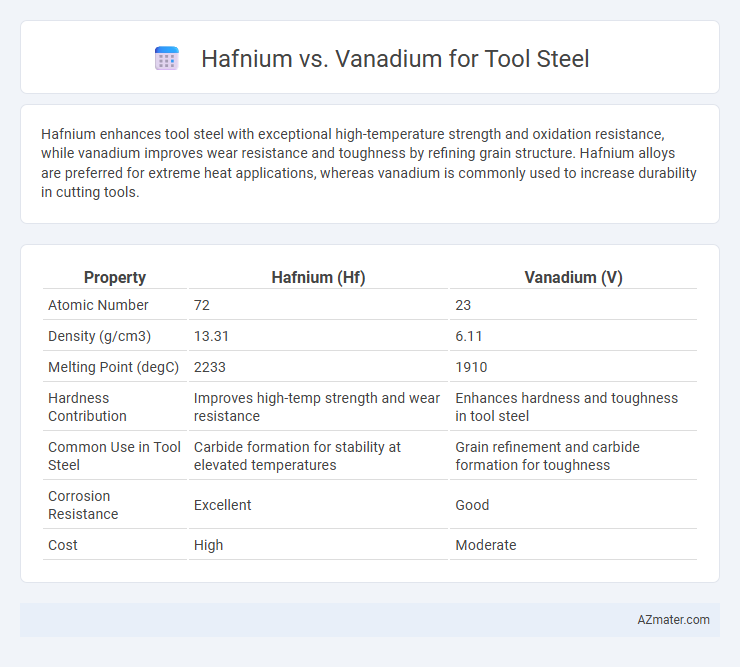Hafnium enhances tool steel with exceptional high-temperature strength and oxidation resistance, while vanadium improves wear resistance and toughness by refining grain structure. Hafnium alloys are preferred for extreme heat applications, whereas vanadium is commonly used to increase durability in cutting tools.
Table of Comparison
| Property | Hafnium (Hf) | Vanadium (V) |
|---|---|---|
| Atomic Number | 72 | 23 |
| Density (g/cm3) | 13.31 | 6.11 |
| Melting Point (degC) | 2233 | 1910 |
| Hardness Contribution | Improves high-temp strength and wear resistance | Enhances hardness and toughness in tool steel |
| Common Use in Tool Steel | Carbide formation for stability at elevated temperatures | Grain refinement and carbide formation for toughness |
| Corrosion Resistance | Excellent | Good |
| Cost | High | Moderate |
Introduction to Hafnium and Vanadium in Tool Steels
Hafnium and vanadium are critical alloying elements in tool steels, enhancing performance through distinct mechanisms. Hafnium improves high-temperature strength and oxidation resistance, making it valuable for cutting and hot-work tool steels. Vanadium contributes to wear resistance and toughness by forming stable carbides, essential for maintaining hardness and durability in demanding tool applications.
Chemical Properties Comparison: Hafnium vs Vanadium
Hafnium exhibits a high melting point of approximately 2233degC and exceptional corrosion resistance, making it valuable for improving high-temperature stability in tool steels. Vanadium, with a melting point around 1910degC, significantly enhances hardness, wear resistance, and toughness through the formation of vanadium carbides in tool steels. The chemical affinity of vanadium for carbon atoms facilitates carbide precipitation, whereas hafnium's carbide-forming ability is less prominent but offers superior oxidation resistance.
Effects on Steel Microstructure
Hafnium refines the grain structure of tool steel by forming stable carbides that enhance hardness and high-temperature strength, improving wear resistance and toughness. Vanadium contributes to microstructural refinement through the formation of vanadium carbides, which inhibit grain growth and promote a uniform distribution of fine precipitates, resulting in increased hardness and improved resistance to abrasion. The combined presence of hafnium and vanadium in tool steel optimizes carbide morphology, leading to superior mechanical properties and enhanced heat resistance during demanding industrial applications.
Impact on Hardness and Strength
Hafnium in tool steel enhances hardness by refining carbides and improving wear resistance, contributing to superior strength under high-stress conditions. Vanadium significantly increases hardness through the formation of stable vanadium carbides, which also improve toughness and resistance to abrasion. The combination of these elements optimizes tool steel performance by balancing high hardness with enhanced strength and durability.
Wear Resistance Performance
Hafnium-enhanced tool steels exhibit superior wear resistance compared to vanadium-containing alloys due to hafnium's ability to form stable, hard carbides that impede abrasive wear. Vanadium contributes to wear resistance by promoting fine vanadium carbide precipitates, but hafnium carbides are generally more thermodynamically stable, enhancing hardness retention at elevated temperatures. Consequently, hafnium-alloyed tool steels demonstrate improved durability and longevity in high-stress wear applications.
Corrosion Resistance Differences
Hafnium offers superior corrosion resistance in tool steel applications due to its high chemical stability and strong resistance to oxidation and acidic environments. Vanadium enhances hardness and wear resistance but is more prone to corrosion, particularly in aggressive environments, requiring protective coatings or alloying elements for durability. Choosing hafnium can significantly improve tool longevity in corrosive conditions compared to vanadium-based steels.
Influence on Toughness and Ductility
Hafnium enhances tool steel toughness and ductility by refining grain structure and promoting stable carbide formation, which improves impact resistance and reduces brittleness. Vanadium contributes to toughness through vanadium carbides that increase wear resistance but can reduce ductility if present in excess due to grain boundary precipitation. Optimizing hafnium content in tool steel alloys leads to a better balance between toughness and ductility compared to vanadium-focused compositions.
Cost and Availability Considerations
Hafnium is significantly rarer and more expensive than vanadium, impacting its cost-effectiveness for tool steel applications. Vanadium is widely available and commonly used as an alloying element in tool steel production, offering a favorable balance of cost and performance. Cost and supply chain stability make vanadium the preferred choice over hafnium for most industrial tooling needs.
Applications in Tool Steel Industry
Hafnium enhances tool steel performance through improved oxidation resistance and thermal stability, making it ideal for high-temperature cutting and forming tools. Vanadium significantly increases wear resistance and hardness by promoting the formation of fine carbides, which is crucial for heavy-duty applications such as molds and dies. Both elements are valued for extending tool life and maintaining mechanical properties under extreme conditions in the tool steel industry.
Choosing the Right Alloying Element: Hafnium or Vanadium
Vanadium is widely used in tool steel for its ability to form stable carbides, enhancing wear resistance, hardness, and toughness. Hafnium, although less common, offers superior high-temperature strength and oxidation resistance, making it ideal for specialized tool steel applications requiring extreme durability. Selecting between hafnium and vanadium depends on the specific performance requirements, with vanadium preferred for general wear resistance and hafnium suited for high-temperature environments.

Infographic: Hafnium vs Vanadium for Tool Steel
 azmater.com
azmater.com